April 5, 2021 | By Jennifer Ring
Traveling Art Project Brings Joy
to Exhausted Families During Pandemic
Details here
Locations and Schedule here
 . . .
. . .
If you’ve frequented Pinellas County parks during the pandemic, you may have noticed a couple of colorful shipping containers with the words Make, Play, Read and Grow painted on their sides. Together, they are SPACEcraft — Mitzi Gordon, Carrie Boucher and Bridget Elmer’s latest traveling art project.
Gordon, Boucher and Elmer have substantial experience with traveling art projects — Gordon with Bluebird Books Bus, Boucher with NOMAD Art Bus and Elmer with Flatbed Splendor. So when Creative Pinellas issued a call for a new traveling art project in 2018, it made perfect sense for these three to apply.
The goal – to create a space that engages the public.
In artspeak, we call this social practice. Social practice is the art of human interaction. And like humans, a social practice art project evolves in response to how folks interact with it.
The first step in any social practice art project, mobile or not, is to create a space that draws people in and encourages human interaction. It’s a challenging task under normal circumstances, but it’s particularly daunting during a pandemic when certain human interactions can be deadly.
I met with Gordon and Boucher in Clearwater’s Eagle Lake Park on a rainy Saturday afternoon to discuss how SPACEcraft came to Pinellas County and how the pandemic changed things.
. . .
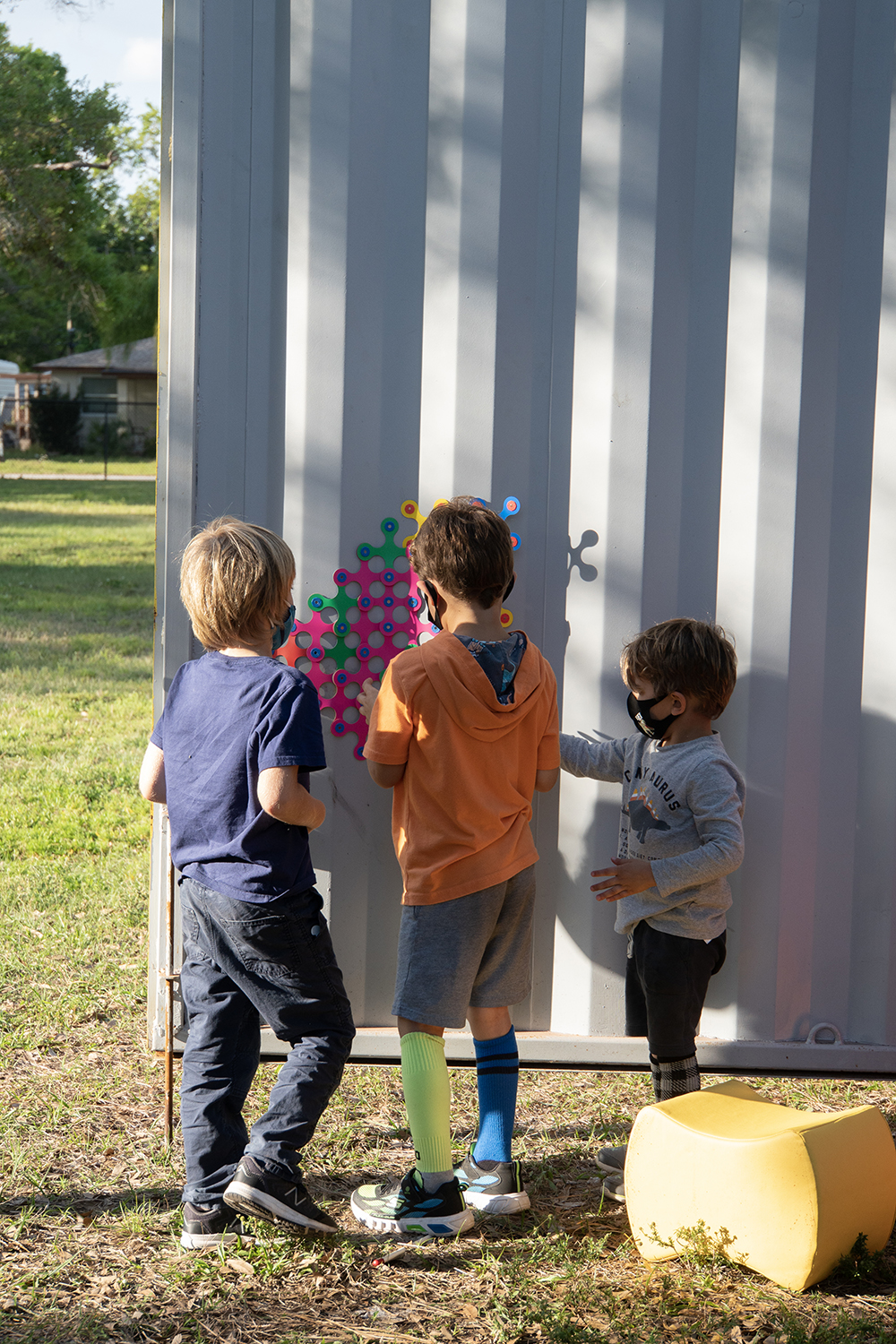
. . .
Creating a Space for Creative Exploration
. . .
Pre-COVID, Team SPACEcraft considered how they could use colors, shapes and other visual cues to bring people together under the umbrella of creativity.
“For me, in a lot of ways, a big part of my practicing art is the creation of the space,” says Gordon, “not just as an object, but in the mind of ‘how are people going to engage?’ How will they feel when they first walk in? What’s the first thing they see? What are they reaching for?’ And thinking about the experience of someone who’s coming into that stage from all of these different angles.
“For me, there’s an art to creating that type of experience. To curate a space and materials and colors and an environment that encourages the activity — that encourages curiosity and exploration.”
“And then on the next iteration, asking, ‘what if we put this over there?'” says Boucher. “It’s that curating an experience, but also having that experience evolve.”
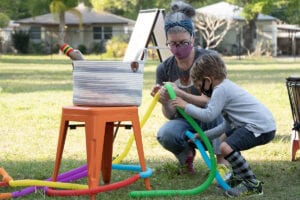
How does one create a space that encourages curiosity and exploration?
First, it has to draw people in and color is a big part of that.
“Circles of color are things that bring us joy,” says Boucher, referencing Ingrid Fetell Lee’s The Aesthetics of Joy.
In difficult times, the promise of joy is particularly alluring. Gordon and Boucher have seen this play out first-hand during the pandemic.
During the week Gordon was setting up the Read/Grow container in Clearwater’s Eagle Lake Park, several people took notice. If the door was open, even just a crack, people would come up to Gordon and ask, “What is this? I saw it from over there and I’m so curious.” It’s something she’s been hearing more and more of lately.
“It just gives me so much joy because that’s exactly what we want,” says Gordon.
“They know it’s for them,” says Boucher. “If it were just a single color and there was nothing on it, people would think it was park storage or something like that. But there’s something about two colors and big words on the outside that tells people it’s for them… It calls to them.”
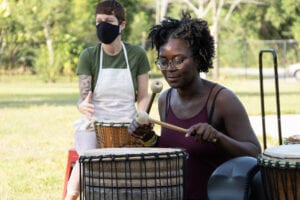
Gordon and Boucher use color as a visual cue to engage in various creative tasks throughout SPACEcraft.
“Color can carry so many associations,” says Gordon. “When I started Bluebird, one of the first things I did was arrange the books by the color of their spine instead of by subject to see what kind of associations showed up. Like, what do these two blue books say together? And when people came into the space, ‘what’s the color that they reach for first?’”
This way, Gordon forced Bluebird visitors to choose by color before they could even consider the subject.
“You’re drawn to a color first,” says Gordon, “and you don’t know what you’re going to find.”
The team carried this idea to SPACEcraft in 2018, organizing the entire project into four colors. The idea was to take each aspect of creativity and give it a name and a color.
“Collectively, the three of us had several conversations around that,” says Gordon. “The goal was to distill creative activity into some very basic concepts that were broad and yet approachable.”
“I’ve been really studying human creativity for a while,” says Boucher, “and it felt to me like, with these four things [Make, Play, Read and Grow], we could hit most of what that is.”
. . .
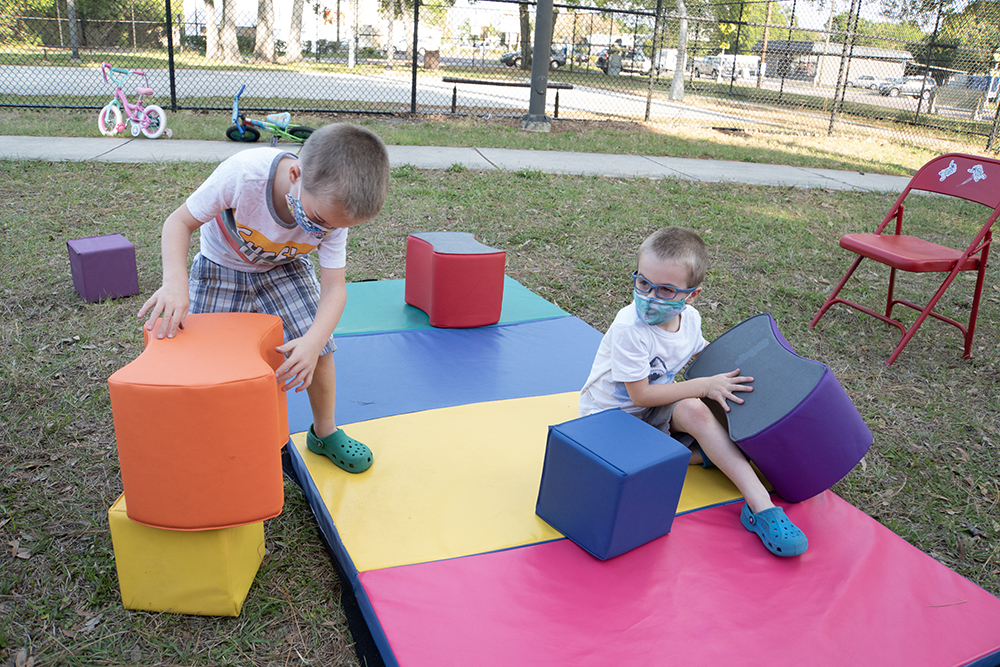
. . .
Each word was as carefully selected as the activities it represents.
READ. If they’d used the word ‘write’ instead of ‘read,’ well, there aren’t a lot of people walking in the park on a beautiful day who would see that and think, “It’s such a beautiful day, but I should really be writing.” But it’s quite common for folks to bring a fun novel to the beach on a beautiful day and read, hence the ‘beach read’ genre.
Gordon and Boucher’s Read space allows one to approach words and meaning from multiple, fun directions – from magnetic poetry to making books. But we read more than books and poems, as Gordon points out, “we read maps, people read Tarot cards and tea leaves.”
“There’s space that’s open for somebody to come to us and say, ‘I read people’s star charts,’” says Boucher.
The multifarious possibilities allow the team to expand upon their initial vision with programming partners like Haley Smith. Smith taught local kids how to make paper from recycled pulp, and then how to stitch those pages into a homemade journal.
GROW. “We had an artist [Noelle Stillman] create a mural in the Grow space,” says Gordon. “She’s making a zine with seed paper that’s going to be essentially a part of both spaces because you can plant with seed paper and the book is a handmade piece that she contributes.”
“She also facilitated printmaking with native plants in the Make space,” Boucher continues.
. . .
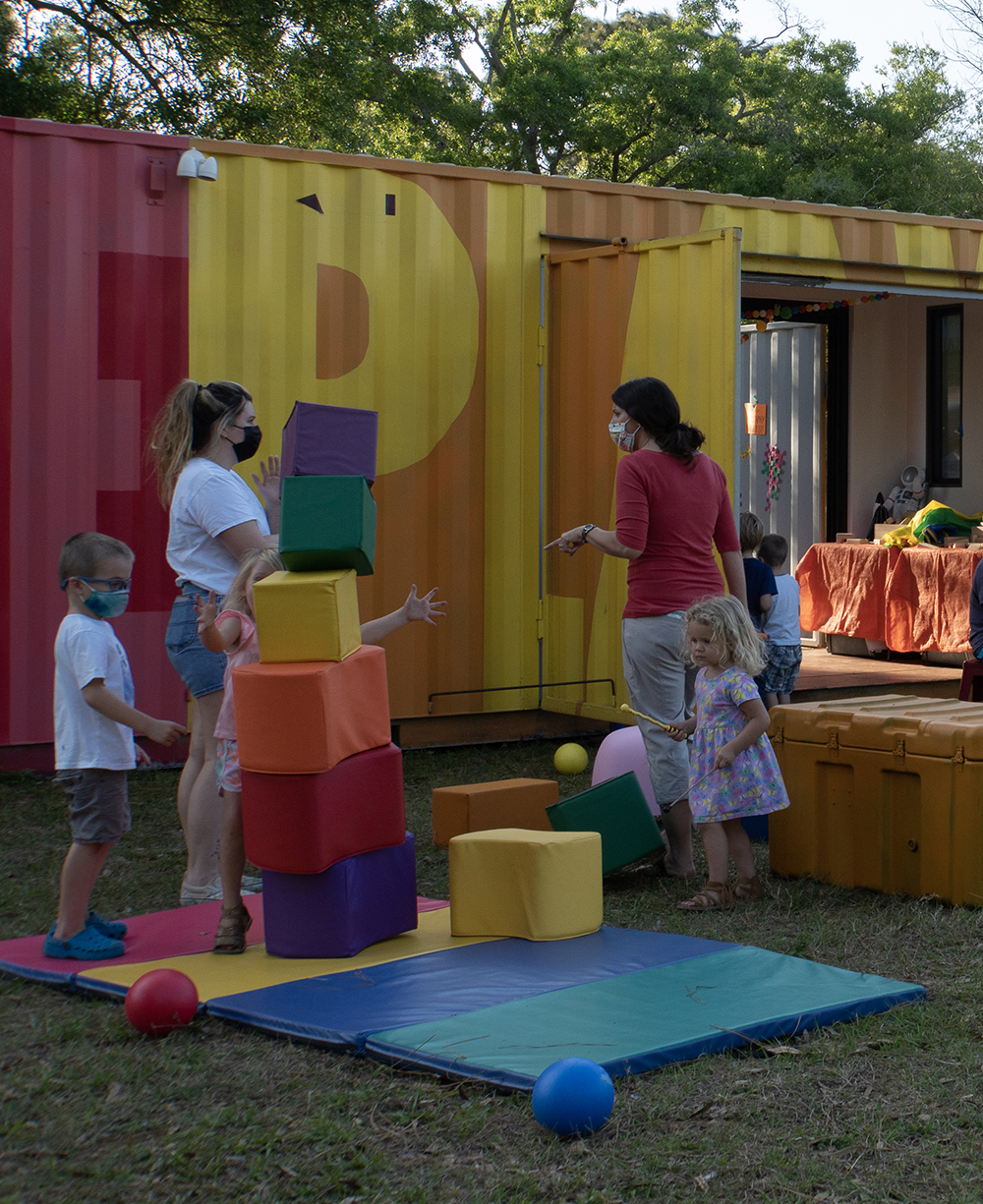
. . .
MAKE. Team SPACEcraft chose the word ‘make’ instead of ‘art’ so they wouldn’t scare away non-artists.
Boucher encounters the art intimidation factor first-hand through her NOMAD Art Bus. Boucher tells me people often walk up to the bus and say, “I’m not an artist.”
“If you look at some of the things people are painting on the outside, like, you don’t have to be an artist to paint the NOMAD Art Bus,” says Boucher, “but people are still intimidated by the idea of doing art in a public setting.”
As an artist, it was hard for Boucher to wrap her head around this at first.
“Because it’s so natural for me, I couldn’t understand,” she tells me. “If you look at what people are painting, nobody’s painting anything awesome. So why would anybody be afraid to do it?”
It wasn’t until Boucher was asked to participate in an unusual game at an art conference a few years back that she finally understood. The game was a lot like Jenga, but life-sized.
“You had to use a mallet,” she recounts. “It was a really physical activity, and I was not prepared. I’ll do sporty things in my own world. But doing them in public? Here I am in a room with 30 people and I have to use this bat to swing. That was so intimidating. It wasn’t difficult to do, but I didn’t get to practice. I had no idea how I was going to approach it.”
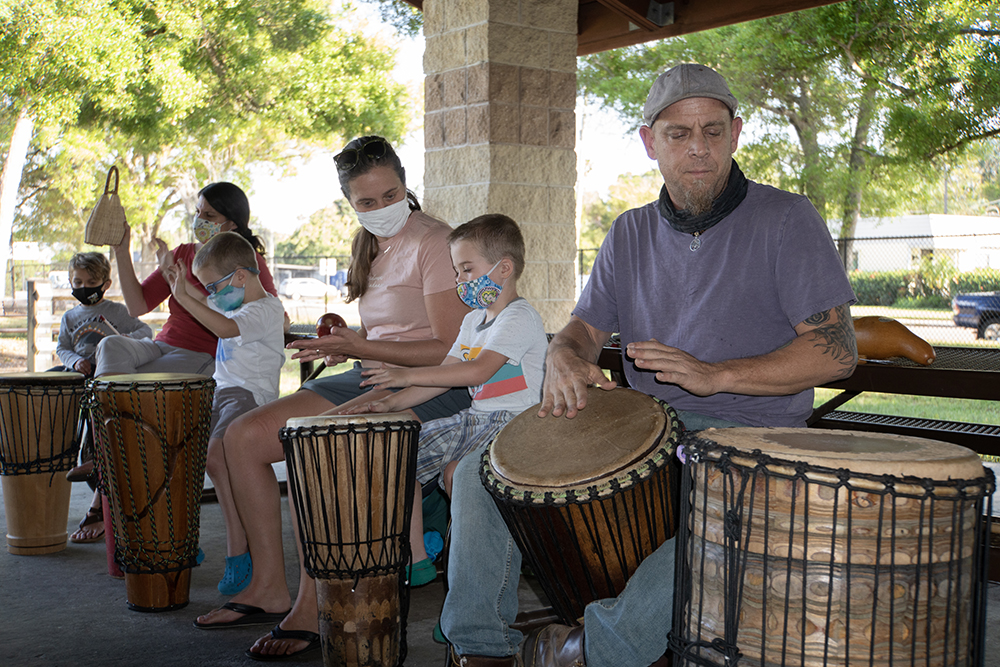
PLAY. What Make is to art, Play is to music. Not everyone plays a musical instrument. However, everybody plays in one way or the other.
“Play is so broad,” Boucher tells me, “we play music, we play movies, we play songs, we play games.
On my subsequent visit to St. Pete’s Lealman Park, Steve Turner (@givingtreemusic) was playing drums with a group of about seven kids and parents around the Make/Play space. I have no idea if these kids played the bongos before that afternoon, but with some instruction from Steve, they were happily drumming away as if they do this every weekend. And maybe some of them have, during the pandemic.
All Together Now
Boucher tells me that SPACEcraft became a refuge for exhausted parents during the pandemic.
“The first people who came and started engaging were parents with young children, because after months on end of having to come up with every single thing that your kid does, they were so happy to see that their kids could go and just be creative,” says Boucher. “Parents were just feeling this, ‘can somebody just take my kid for like 30 minutes and they do an activity that I don’t have to think of and I don’t have to clean up after?’”
. . .
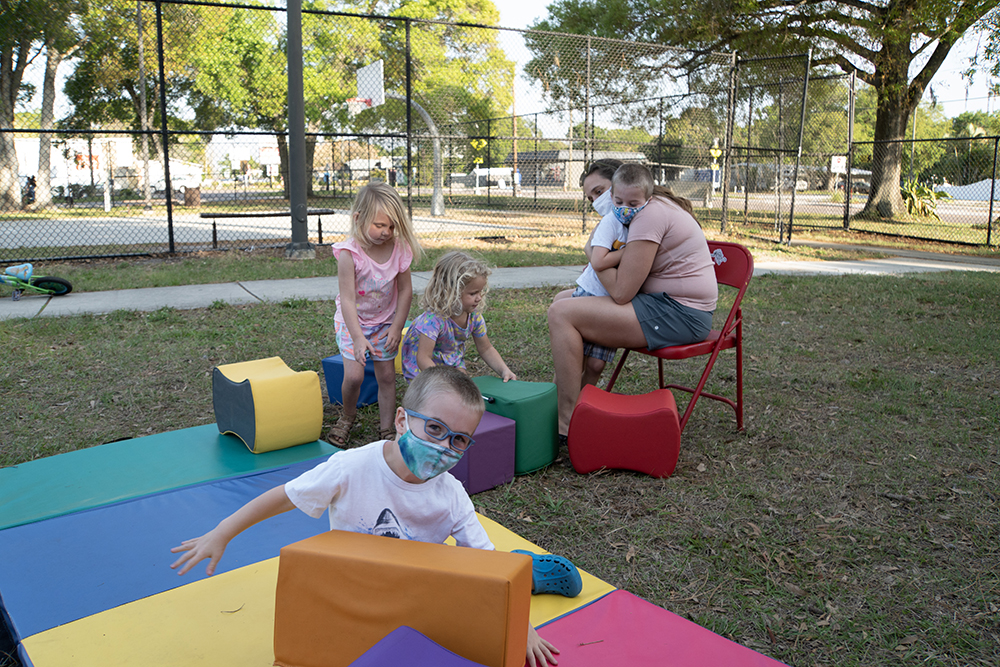
. . .
For families who ventured out in search of relatively safe outdoor activities during the pandemic, Team SPACEcraft provided a space for kids to explore all aspects of creativity, from writing to music to art.
“Hopefully, out of the four themes, there’s at least one that every person can feel comfortable doing or exploring,” says Boucher.
“I feel like we’ve also tried to create different levels of engagement with each space,” says Gordon, “so if you approach one that you’re not very comfortable with, there’s still something basic that you can do that will draw you in, or maybe not.”
The goal is for families to explore all aspects of creativity and decide which are for them. As a result, several young kids were able to launch their own journeys of creative exploration during the pandemic just as we all were trying new things in an effort to find joy despite our current predicament.
. . .
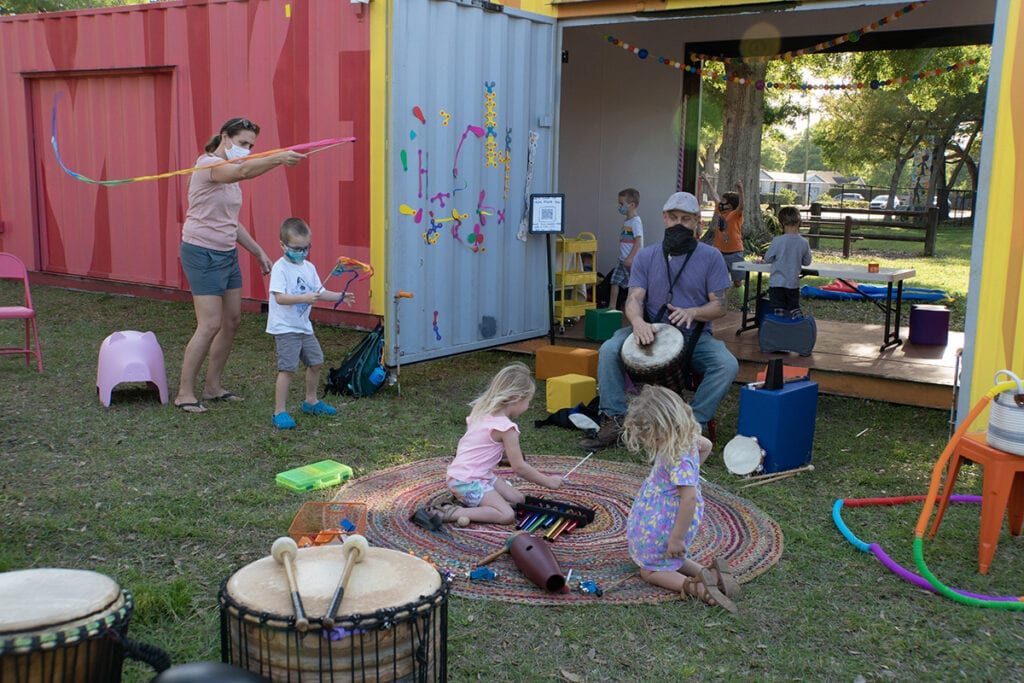
. . .
In addition to providing activities for youngsters, SPACEcraft provided a space for people to practice human interaction under the new rules of COVID. The project was always about human interaction, but the pandemic added another layer to it by changing the ways in which we interact.
In doing so, SPACEcraft served as an important reminder that sometimes you have to get creative if you want to survive.
“There are people who are comfortable with the way things are, and then you have the people who are always pushing outside of that,” says Boucher. “It takes the kind of people who are comfortable with the unknown to take that step into that space, and then show the other people that it’s okay.
“This is a new vision for how we could do it. It is possible. We can do this. We have to do it with thought and care and with intention, but I feel like it’s always the artists, and I use that really broadly, that create a vision for how the future could be. And that’s kind of what we felt was our job with this.”

To keep tabs on this exciting project, follow SPACEcraft
on Facebook and Instagram
@exploreSPACEcraft
Photos by Jennifer Ring




